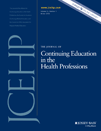AOSpine
Faculty Focus
2-2014
Content

Commitment
to Change
Questionnaire
A Commitment to Change (CTC) questionnaire characterizes what learners find most valuable in an educational experience by asking what they subsequently intend to improve in their clinical practice. Several AOTrauma orthogeriatrics courses have successfully integrated this tool to better serve learners, faculty, and curriculum planners.
Fostering practice improvement following our educational events

“The Commitment to Change statement is a simple but elegant tool that allows us to assess the success of our educational activities at a high level. It shows us not only what the participants learned in terms of knowledge but also if and how it affected their daily practice."
— Stephen Kates MD
Rochester, NY, USA

Cunningham M,
Kates S,
Blauth M.
Using a commitment to change tool for evaluation and planning of a global competency-based curriculum in orthogeriatrics.
J Contin Educ Health Prof. 2014;34(2):129–136.
The AOTrauma Orthogeriatrics Education Taskforce recently published a paper on the use of CTC surveys in their courses in the Journal of Continuing Education in the Health Professions (JCEHP), a leading peer-reviewed journal in medical education.
What is CTC?
The CTC tool is a questionnaire used at the end of an educational activity to help learners put into practice their newfound knowledge and skills and to help educators assess learning and improve the curriculum and materials.
The AO version of the survey asks learners, if (as a result of the course they just finished) they intend to make a change in their practice, what that change is, and to rate their level of commitment to making that change. A follow-up email is sent to participants 3 months later to ask, if they have implemented the changes fully, partially, or not at all and to identify any barriers to making those changes.
Facilitates reflection
The advantages of CTC lie in its benefits for both educators and learners. It enables learners to reflect on their current practice as well as newly learned material and to identify areas of improvement to implement.
Educators receive feedback on the value of the course content and how the participants were able to successfully translate learning into clinical practice.
As Dr Michael Blauth notes, "nowadays in education the outcomes of a course or program are often unknown. The CTC tool is a way of uncovering the accomplishments of an educational activity."
The study
In their new research, authors Mike Cunningham from the AO Education Institute and surgeons Stephen Kates and Michael Blauth examined the CTC questionnaire and follow-up survey data from eight AOTrauma courses on the topic of orthogeriatrics between 2010 and 2012.
Just over half of the 513 course participants filled out the CTC survey and reported 485 specific intended changes. These changes were categorized and quantified based on ten competencies for orthogeriatrics. The competencies with the highest number of intended changes overall were "address secondary prevention", "build a system of care", and "initiate and comanage patient care".
At the 3-month follow-up, the authors reported that 75% of changes had been implemented to some degree (24% fully implemented, 51% partially implemented) and 25% had not been implemented. The most commonly reported barriers to implementation were “ongoing process (needs more time)” and “requires more discussion, collaboration, or support”.
All the data from the research project has been used by the planning committee to improve the orthogeriatrics curriculum by identifying content that had to be adjusted and new materials that have since been developed to address the reported barriers. Full details are available in the published article: Using a commitment to change tool for evaluation and planning of a global competency-based curriculum in orthogeriatrics by Mike Cunningham, Stephen Kates, Michael Blauth.
AOTrauma to use this tool
The success of CTC in orthogeriatrics courses has led AO to prioritize the use of this tool in AOTrauma and other clinical divisions.
As Michael Blauth noted, "so far at AO we have not systematically collected the CTC statements from participants and often made no follow up. We plan to change this now. We want to use this tool in a smart and effective way so it can provide us with continuous quality improvement feedback."
While this process is resource-intensive, the benefits are myriad and will help AO continue to be a world leader in continuing medical education.
AOSpine
www.aospine.org | education@aospine.org
Copyright © 2014 AO Foundation. All rights reserved.



